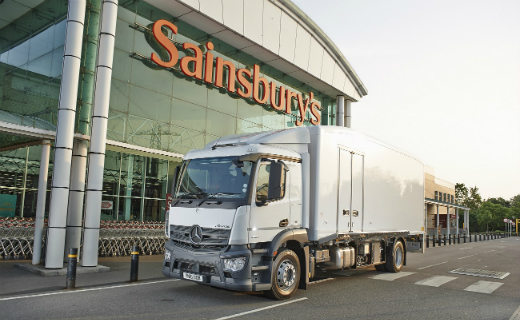Dearman refrigerated truck tech trial
- PostedPublished 21 August 2016
Sainsbury’s is participating in a unique trial involving a zero-emissions cooling unit for a refrigerated delivery truck as the British supermarket giant aims to dramatically reduce its carbon emissions and cooling supplier Dearman looks to prove its engine technology.
Well known for pioneering refrigerated truck technology, including a three-year field trial currently underway using Carrier Transicold chiller systems with R744 (carbon dioxide) refrigerant, Sainsbury’s latest initiative with Dearman and its partners is billed as the world-first commercial application of cooling a refrigerated delivery truck using a liquid nitrogen-powered engine.
Fast gaining attention in the UK and Europe, the so-called Dearman Engine replaces a traditional diesel engine and is designed to eliminate all emissions associated with refrigeration, including nitrogen oxide (NOx) and particulate matter (PM).
Dearman claims it also results in substantial well-to-wheel carbon dioxide (CO2) savings and reduces operating costs compared to traditional refrigeration units. Liquid nitrogen is a non-flammable substance, too.
The system works in two ways. About two-thirds of the refrigeration comes from pumping the liquid nitrogen (stored at about 3 bar in a cryogenic vessel) to about 40 bar and transferring it to a vaporising heat exchanger, where it provides cooling for the chilled compartment.
The other third is produced via the Dearman Engine, which is a piston engine driven by the expansion of liquid nitrogen between the liquid and gas phase. It operates like a high-pressure steam engine, but the low boiling temperature of liquid nitrogen means that low-grade or ambient heat can be used as a heat source, eliminating the need for traditional fuel.
A unique feature of the engine is the use of heat exchange fluid (warm water), which is pumped into the cylinder and then combines with the cryogenic gas. The resulting expansion produces shaft power, which is enough to drive the compressor of a vapour compression refrigeration cycle that provides additional cooling.
The engine also supports ancillary systems such as feed pumps, an alternator and air circulation fans.
The heat exchange fluid in the engine is constantly reclaimed, reheated and reused, while the only emission back into the atmosphere is nitrogen or air.
Sainsbury’s is conducting a three-month trial with the system and expects the single pilot vehicle – operating from its Waltham Point depot and delivering chilled goods to stores in the London area – to save up to 1.6 tonnes of CO2, 37kg of NOx and 2kg of PM, compared to a similar diesel system.
The CO2 figure alone is said to be the equivalent of driving more than 14,500km in a modern family car.
“As one of Britain’s biggest retailers we really recognise the importance of reducing emissions, which is why we’re working hard to cut carbon emissions by 30 per cent between 2005 and 2020,” said Sainsbury’s head of sustainability Paul Crewe.
Dearman founder and CEO Toby Peters said: “The first commercial deployment of Dearman’s zero-emission transport refrigeration system is a significant milestone for the company, for our technology and for our vision to make the world a cleaner, cooler place.”
- CategoriesIn SightGlass
- TagsCold chain, refrigerated transport, SightGlass News Issue 7, transport refrigeration





